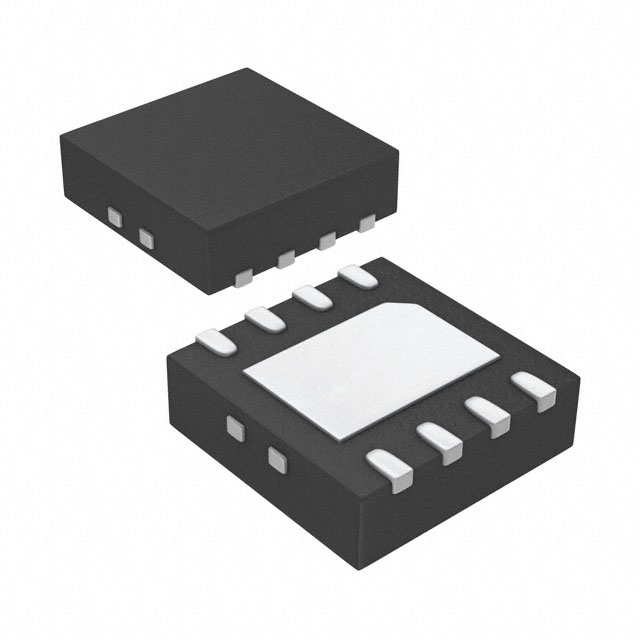LTC6244HVCDD#TRPBF
Product Overview
Category: Integrated Circuit (IC)
Use: The LTC6244HVCDD#TRPBF is a high voltage, low noise operational amplifier designed for precision applications. It is commonly used in various electronic circuits where accurate amplification and signal conditioning are required.
Characteristics: - High voltage operation - Low noise performance - Precision amplification - Wide bandwidth - Rail-to-rail input and output swing - Low input bias current
Package: LTC6244HVCDD#TRPBF is available in a compact 8-pin DFN package, which ensures easy integration into circuit designs.
Essence: This IC is specifically designed to provide high voltage amplification with low noise characteristics, making it suitable for applications that require precise signal processing.
Packaging/Quantity: The LTC6244HVCDD#TRPBF is typically packaged in reels or tubes, containing a specific quantity of ICs per package. The exact packaging and quantity may vary depending on the supplier.
Specifications
- Supply Voltage Range: ±2.7V to ±12V
- Input Offset Voltage: 500µV (maximum)
- Input Bias Current: 1pA (maximum)
- Gain Bandwidth Product: 10MHz
- Slew Rate: 5V/µs
- Output Current: 30mA (maximum)
- Operating Temperature Range: -40°C to 125°C
Pin Configuration
The LTC6244HVCDD#TRPBF has the following pin configuration:
```
| | --| IN- VCC |-- --| IN+ OUT |-- --| V- NC |-- --| V+ GND |-- |___________| ```
Functional Features
- High voltage operation: The LTC6244HVCDD#TRPBF can operate with a wide supply voltage range, allowing it to handle high voltage signals effectively.
- Low noise performance: This IC is designed to minimize noise interference, ensuring accurate signal amplification and conditioning.
- Precision amplification: With low input offset voltage and bias current, the LTC6244HVCDD#TRPBF provides precise amplification of input signals.
- Wide bandwidth: The IC offers a wide bandwidth of 10MHz, enabling it to handle high-frequency signals accurately.
- Rail-to-rail input and output swing: The LTC6244HVCDD#TRPBF supports input and output signals that can swing close to the supply rails, maximizing dynamic range.
- Low input bias current: The IC has a very low input bias current, minimizing the impact on sensitive circuits.
Advantages and Disadvantages
Advantages: - High voltage operation capability - Low noise performance - Precise amplification - Wide bandwidth for accurate signal processing - Versatile rail-to-rail input and output swing - Low input bias current reduces circuit interference
Disadvantages: - Limited availability in certain markets - Higher cost compared to standard operational amplifiers
Working Principles
The LTC6244HVCDD#TRPBF operates based on the principles of operational amplifiers. It amplifies the input signal while maintaining accuracy and linearity. The IC utilizes internal circuitry to provide high voltage amplification with low noise characteristics. By carefully controlling the input bias current and offset voltage, it ensures precise amplification of the input signal.
Detailed Application Field Plans
The LTC6244HVCDD#TRPBF finds applications in various fields where precision amplification and signal conditioning are crucial. Some of the common application areas include: - Medical instrumentation - Industrial automation - Test and measurement equipment - Audio signal processing - Sensor interfaces - Data acquisition systems
Detailed and Complete Alternative Models
In addition to the LTC6244HVCDD#TRPBF, there are several alternative models available in the market that offer similar functionality. Some of the notable alternatives include: - AD8628 - OPA2188 - LT6015 - MAX44267
These alternative models provide comparable performance and can be considered as substitutes based on specific requirements.
Word count: 411 words
Lista 10 Vanliga frågor och svar relaterade till tillämpningen av LTC6244HVCDD#TRPBF i tekniska lösningar
Sure! Here are 10 common questions and answers related to the application of LTC6244HVCDD#TRPBF in technical solutions:
Q: What is LTC6244HVCDD#TRPBF? A: LTC6244HVCDD#TRPBF is a high voltage, low noise operational amplifier (op-amp) manufactured by Linear Technology.
Q: What is the voltage range supported by LTC6244HVCDD#TRPBF? A: LTC6244HVCDD#TRPBF supports a wide voltage range from ±2.7V to ±15V.
Q: What is the typical supply current for LTC6244HVCDD#TRPBF? A: The typical supply current for LTC6244HVCDD#TRPBF is around 1.5mA.
Q: Can LTC6244HVCDD#TRPBF operate at high temperatures? A: Yes, LTC6244HVCDD#TRPBF has a wide operating temperature range of -40°C to 125°C.
Q: What is the input offset voltage of LTC6244HVCDD#TRPBF? A: The input offset voltage of LTC6244HVCDD#TRPBF is typically 500µV.
Q: Does LTC6244HVCDD#TRPBF support rail-to-rail operation? A: No, LTC6244HVCDD#TRPBF is not a rail-to-rail op-amp. It has limited output swing capabilities.
Q: What is the gain bandwidth product (GBW) of LTC6244HVCDD#TRPBF? A: The gain bandwidth product of LTC6244HVCDD#TRPBF is typically 10MHz.
Q: Can LTC6244HVCDD#TRPBF drive capacitive loads? A: Yes, LTC6244HVCDD#TRPBF can drive capacitive loads up to 100pF without any external compensation.
Q: Is LTC6244HVCDD#TRPBF suitable for low noise applications? A: Yes, LTC6244HVCDD#TRPBF is designed for low noise performance with a typical input voltage noise density of 7nV/√Hz.
Q: What are some common applications of LTC6244HVCDD#TRPBF? A: LTC6244HVCDD#TRPBF is commonly used in precision instrumentation, data acquisition systems, and industrial control applications.
Please note that the answers provided here are general and may vary depending on specific datasheet specifications and application requirements.


